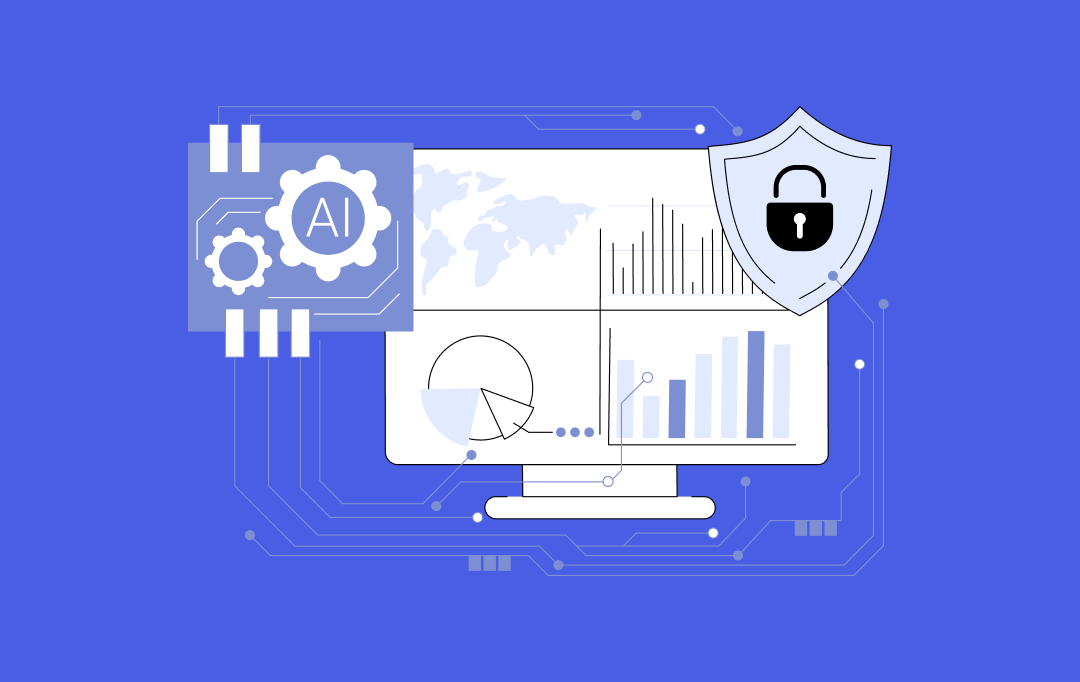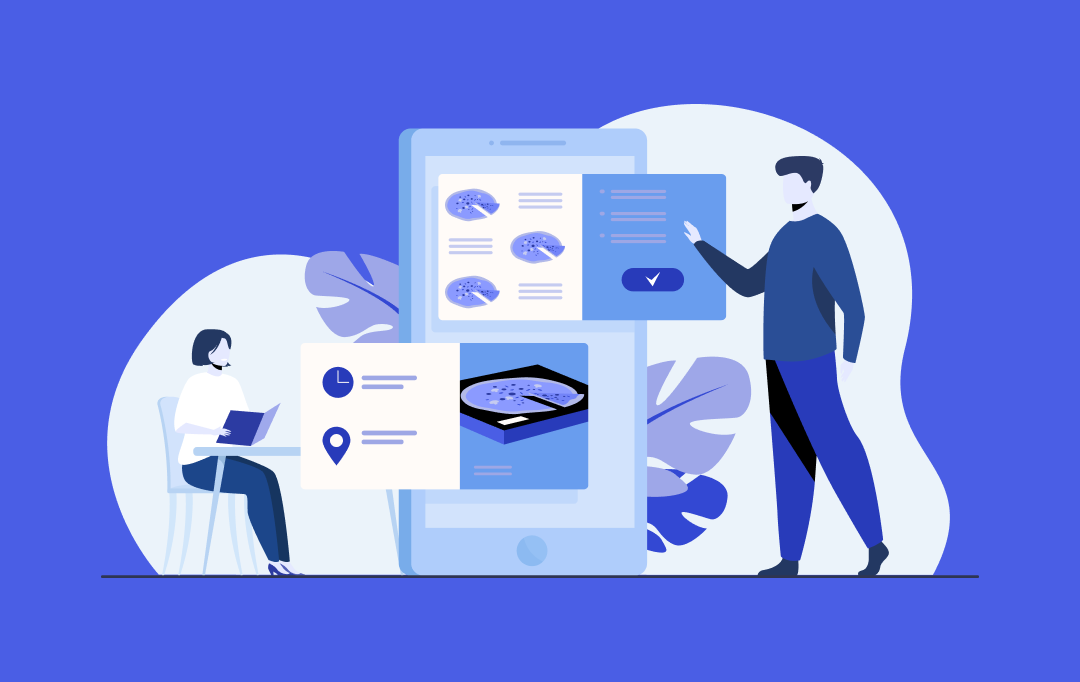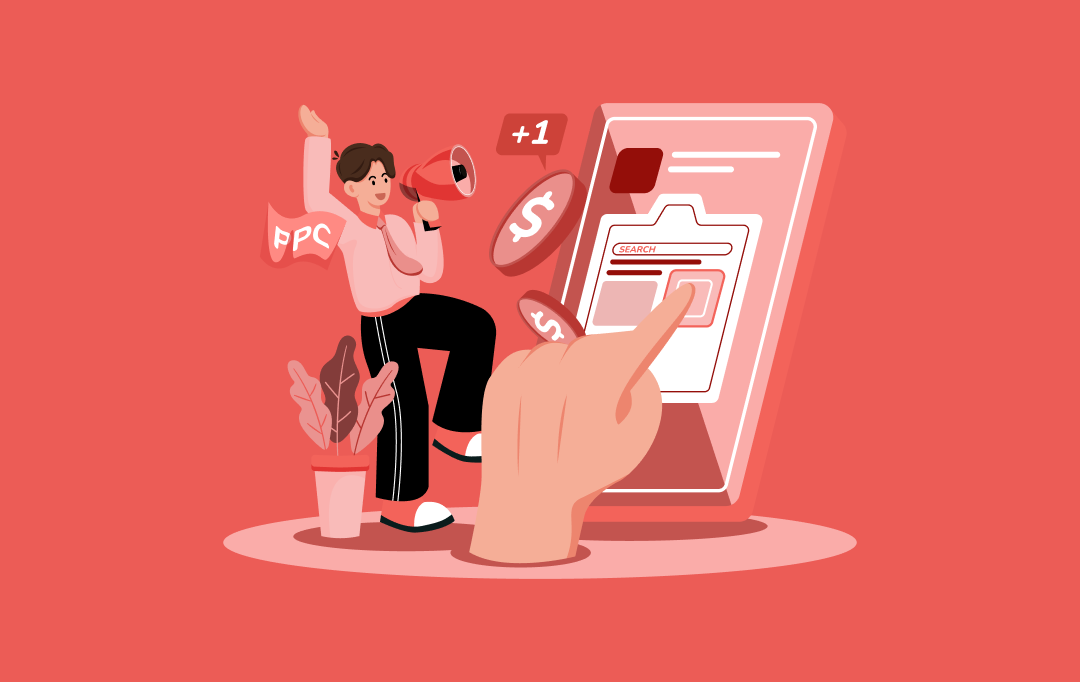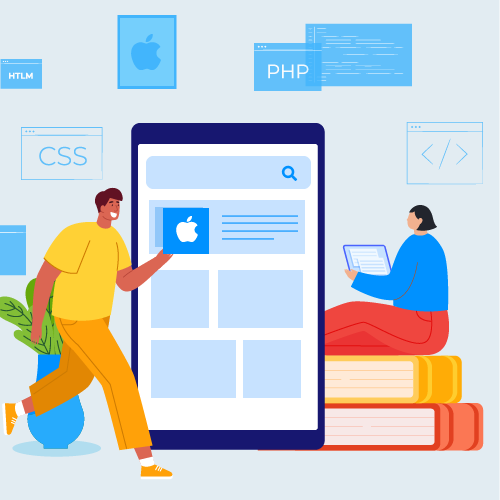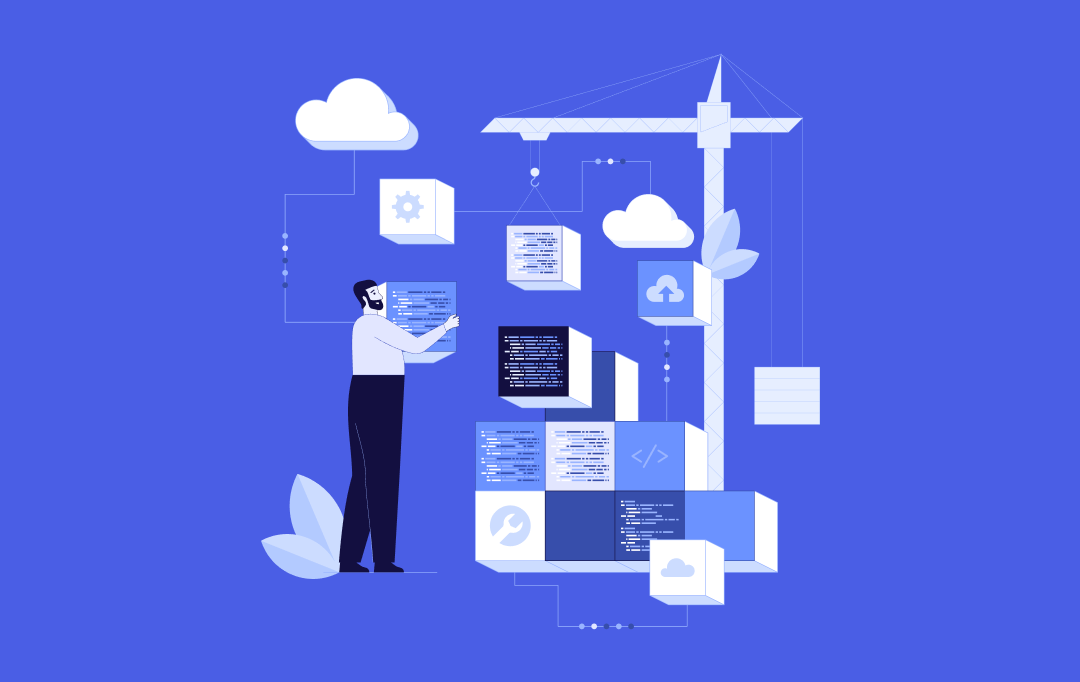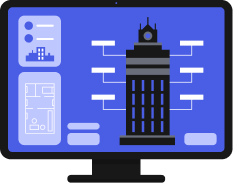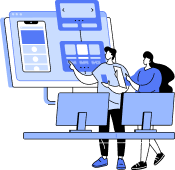- How Do Companies Procure Renewable Energy?
- Green Tariffs
- Direct Agreements With Renewable Developers
- Onsite Renewable Installations
- Electrification of Operations
- Types of Smart Software Solutions in Energy
- Benefits of Smart Software Solutions for Energy Transition
- Smart Energy Control
- Cost Efficiency
- Less Carbon Footprint
- Predictive Maintenance
- Consumer Empowerment
- Key Technologies Behind Smart Software for Sustainable Infrastructure
- Artificial Intelligence and Machine Learning
- Internet of Things (IoT)
- Big Data and Cloud Computing
- Blockchain
- Advanced Sensor Networks
- Edge Computing
- Energy Storage Management Software
- Digital Twin Technology
- Real-World Applications of Smart Software Solutions With Examples
- Smart Grids and Grid Management
- Renewable Energy Integration
- Energy Storage and Management Systems
- Smart Building Management
- Challenges and Considerations in Implementing Smart Software Solutions
- Data Security and Privacy
- Integration with Legacy Systems
- Costs of Implementation
- Regulatory and Policy Barriers
- Employee Skills and Training
- The Future of Energy Transition Software Solutions
- Partner with Appinventiv to Build Smart Software for a Sustainable Energy Future
- FAQs
Key takeaways:
- Smart software solutions are essential for accelerating the energy transition, enabling real-time monitoring, predictive analytics, and efficient integration of renewables.
- Advanced digital tools help organizations cut costs, reduce carbon emissions, and optimize energy use across grids, buildings, and operations.
- Overcoming challenges like data security, legacy system integration, and workforce training is critical for the successful adoption of energy transition software solutions.
- Investing in future-ready energy software empowers businesses to achieve sustainability goals, enhance resilience, and secure a competitive advantage in a low-carbon economy.
When Google teamed up with Microsoft and Nucor last year to advance clean electricity, it demonstrated where global energy is heading. These tech behemoths aren’t sitting around waiting for policies to set the timeline. They’re moving now, investing in solutions that reduce emissions and enhance the reliability of power systems. What they’re doing highlights something important: tech leaders and industrial companies have to work together if we want the energy transition to actually happen.
The numbers back up why this matters so much. IBM’s 2024 State of Sustainability Readiness report found that 76% of executives worldwide now view sustainability as core to their strategy. But only 44% believe their organizations are truly prepared to leverage technology and data to make a meaningful impact. This disconnect reveals that wanting to do something often outpaces being able to do it, creating space for digital solutions to either facilitate or hinder progress.
Again, McKinsey’s Global Energy Perspective 2024 gives us more to think about. Low-carbon energy sources currently account for approximately 32% of global power generation. By 2050, they’re expected to increase to somewhere between 65% and 80%, depending on how events unfold. This growth will primarily come from technologies that are already cost-effective to produce, such as solar, wind, and energy storage systems (Source: McKinsey)
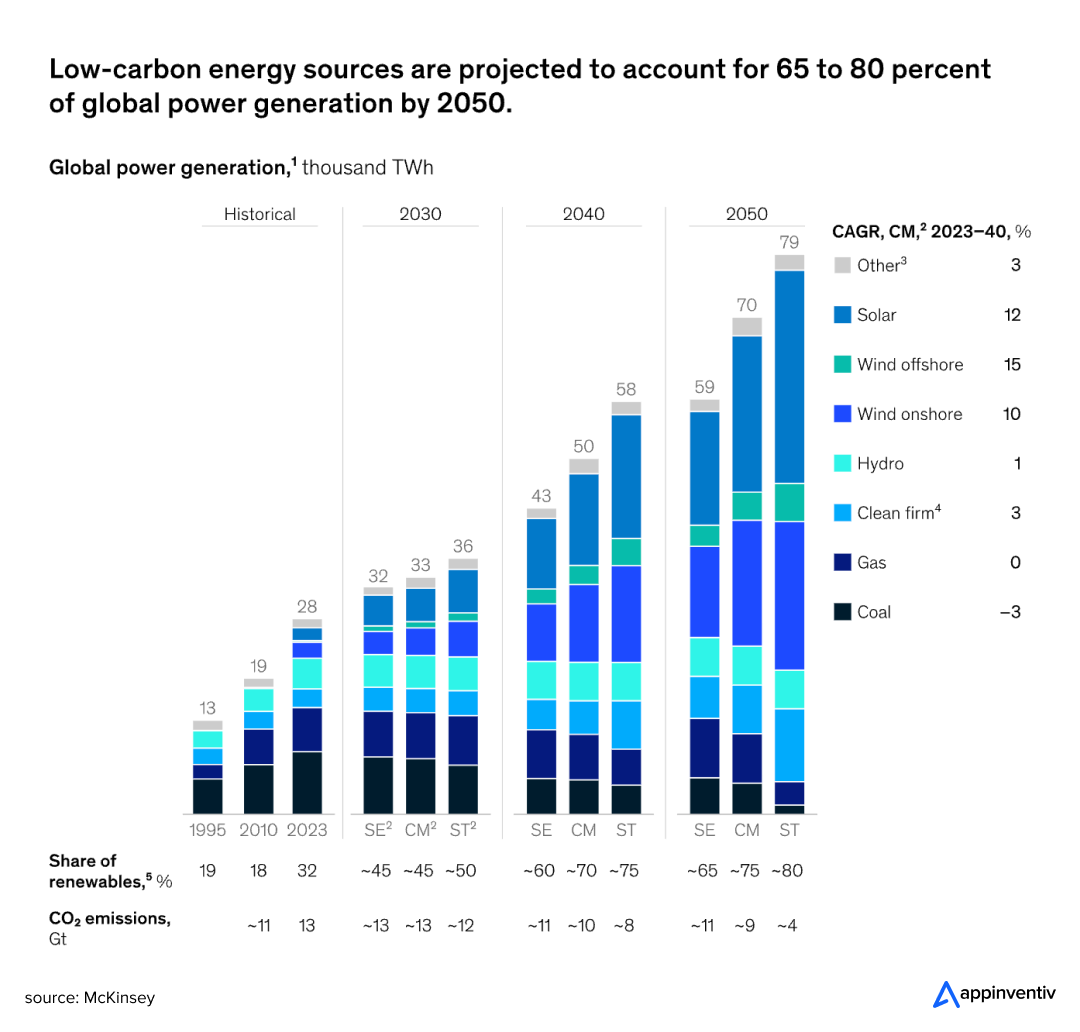
Solar power looks especially promising, as it continues to become more cost-effective compared to other energy sources. Meanwhile, technologies like hydrogen and carbon capture, utilization, and storage (CCUS) are moving more slowly because they cost more and don’t have enough policy backing.
Put it all together and you get a pretty clear view. The energy world is changing rapidly, but it’s happening in fits and starts, and the transition won’t succeed without improved digital infrastructure. This is where smart software for energy transition becomes crucial. Using energy transition software solutions, sustainable infrastructure software, and energy efficiency software, organizations can fine-tune demand, predict supply better, and bring renewables into existing systems on a large scale.
The real challenge isn’t just making clean energy, it’s about managing it properly. Software gives us the practical tools to close that gap, turning good intentions into real results and making sure sustainable infrastructure actually delivers what it promises.
In this blog, we will explore how companies can drive the energy transition through sustainable software development. We will examine renewable energy procurement, categories of smart energy solutions, the benefits they bring, enabling technologies, real-world applications, challenges to address, and what the future may hold. Let’s begin.
Invest in advanced energy software today to optimize resources, strengthen resilience, and secure a low-carbon future
How Do Companies Procure Renewable Energy?
Switching to renewable energy isn’t just about finding green sources; companies need practical ways to actually buy and incorporate clean power into their operations. Here’s how most businesses approach it:
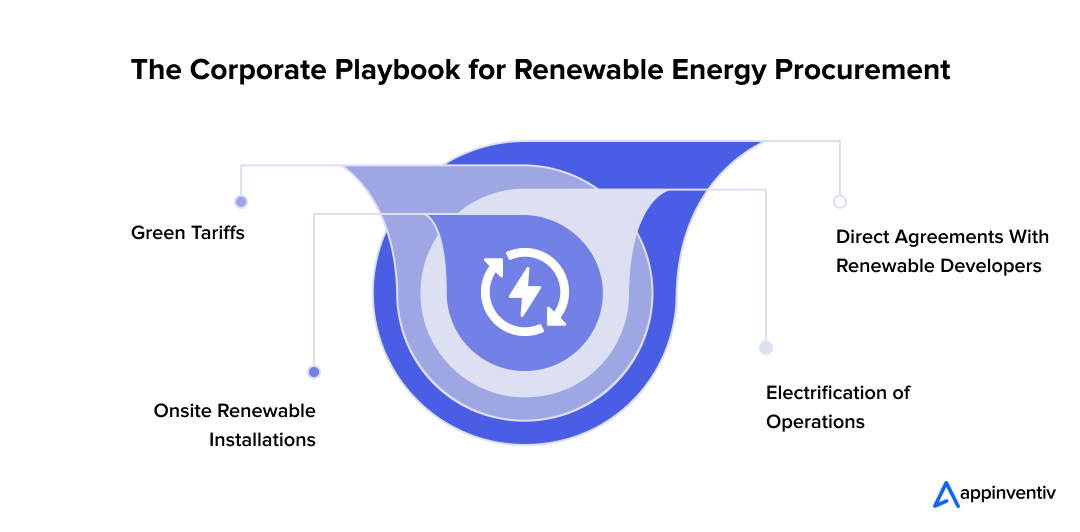
Green Tariffs
Utility companies have created programs where businesses can purchase electricity sourced from renewables, typically for a modest premium. Companies that combine this with energy management systems (EMS) can monitor their usage patterns and optimize consumption while supporting renewable development in their region.
Direct Agreements With Renewable Developers
Some organizations prefer working directly with solar, wind, and other clean energy project developers through long-term contracts. This strategy delivers stable pricing and reliable supply commitments. Many of these partnerships now incorporate AI renewable energy assets to predict power generation and align it with actual demand patterns.
Onsite Renewable Installations
More companies are installing solar panels, wind turbines, and similar equipment on their own property to reduce their reliance on the grid. Power and renewable energy software solutions help these systems work without hiccups, while built-in storage and monitoring keep everything running smoothly day and night.
Electrification of Operations
Businesses are replacing fossil-fuel-powered equipment with electric alternatives: vehicles, heating systems, manufacturing machinery, and more. The trick is using energy transition software solutions to map out the switch and get the most from each system. Stack that with renewable energy software solutions, and companies see major emission cuts while actually meeting those sustainability goals they’ve been talking about.
Types of Smart Software Solutions in Energy
Today’s energy sector leans heavily on smart software solutions to drive efficiency improvements, slash costs, and hit sustainability benchmarks. Different solutions target specific areas of energy management, covering everything from power generation to how we actually use that energy.
Energy Management Systems (EMS): Energy management software for sustainability keeps tabs on, directs, and optimizes the use of energy in industrial, commercial, and utility operations. With live data feeds and automated controls, EMS delivers better energy efficiency, trims operating costs, and pushes forward meaningful carbon reduction goals.
Grid Optimization Software: Smart grid software solutions boost power grid performance by syncing supply with demand, keeping voltage levels stable, and cutting energy losses. These platforms make renewable energy integration work smoothly while keeping the entire network reliable and resilient.
Smart software for the energy transition enables operators to view real-time data on electricity supply and demand, mitigating inefficiencies in grids and preventing overloads, with IoT’s transformative role in Middle Eastern smart grid development serving as a prime example of regional innovation.
Renewable Energy Integration Platforms: Net-zero software solutions facilitate the integration of solar and wind, and other renewable types of energy into the existing energy base. They offer predictive, reporting, and management to ensure the most efficient energy generation and reduce wastage, and implement sustainability initiatives.
Smart Building Management Software: The smart building management software is used to automate lighting, heating, cooling, and other systems of commercial and residential areas ,depending on the occupancy and usage patterns. It minimizes waste of energy, thereby enhancing efficiency,and costs are minimized as well as making it contribute towards responsible building operations of the environment.
Demand-Side Management Software: This software is aimed at consumers and businesses and allows them to take direct control of how much energy is used. It has enabled sustainable energy use by stimulating off-peak load, incorporating smart appliances, and studying consumption patterns to ease grid load and create sustainable energy use.
Benefits of Smart Software Solutions for Energy Transition
Smart software is becoming instrumental in the rapid transition of the world to cleaner and more efficient energy systems. These tools allow businesses, governments, and consumers to make this energy transition both precise and sustainable by incorporating real-time monitoring, predictive analytics, and automation. Key benefits include:
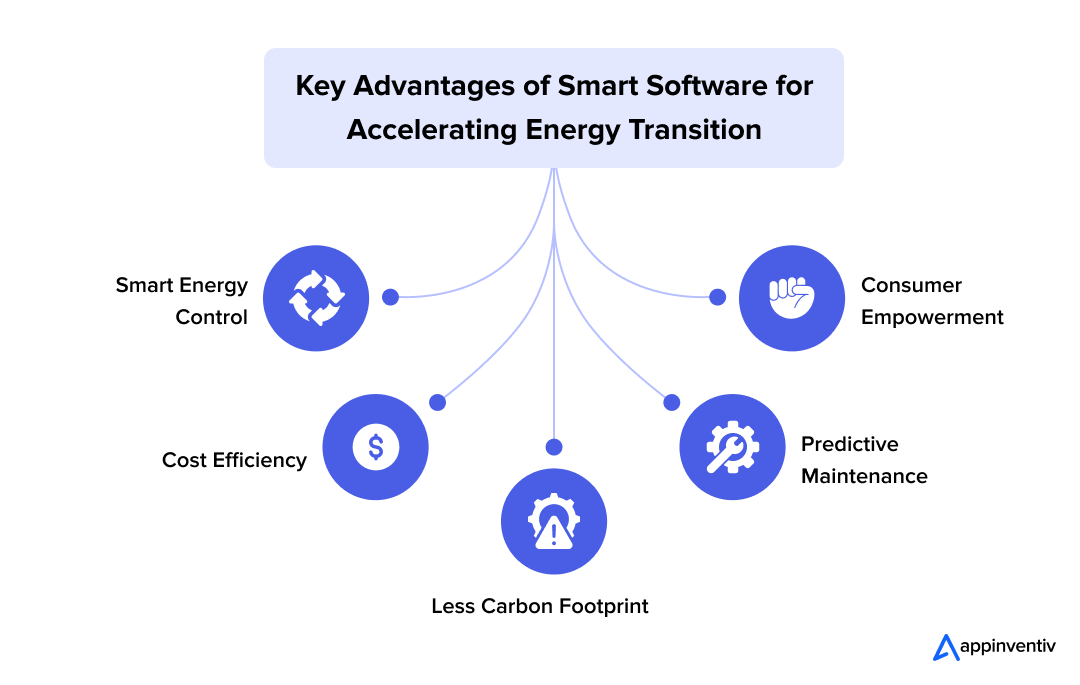
Smart Energy Control
Smart software for the energy transition enables operators to view real-time data on electricity supply and demand, mitigating inefficiencies in grids and preventing overloads. These solutions help to easily integrate renewable energy sources to provide a steady and continuous power supply.
Through the power of energy transition software solutions, utilities and operators have the ability to strategically plan the distribution of energy, making the systems more resilient and contributing to the sustainability of the country and businesses as a whole.
Cost Efficiency
Digital solutions for energy transition can assist the organization in studying the consumption trends, economize resources, and avert expensive equipment malfunctions. Predictive analytics and automation streamline operations and generate less energy waste, and allow fewer operations, saving costs.
Sustainable infrastructure software is not only efficient but also offers financial advantages, enabling energy providers and industries to make the necessary sustainability commitments without compromising their profitability.
Less Carbon Footprint
Renewable energy software solutions facilitate the integration of solar, wind, and other clean energy sources into existing grids, resulting in reduced reliance on fossil fuels. These tools are used to give practical information to reduce emissions, facilitate carbon accounting, and determine energy consumption in accordance with regulatory provisions.
Smart software for the energy transition ensures that environmental goals inform all decisions by helping organizations achieve greener operations and promote a low-carbon future.
Predictive Maintenance
Green energy software development will provide the operators with sophisticated monitoring systems to monitor equipment performance at any time. Possible failures are detected in advance, thereby limiting downtime and prolonging the life of the infrastructure.
Maintenance with energy transition software solutions can be arranged in advance, saving money and not interrupting the delivery of energy, and this is highly important in the activities of industrial and renewable energy.
Consumer Empowerment
The smart software solutions provide both businesses and households with comprehensive data on energy usage, enabling them to make informed decisions about energy use and achieve efficiency gains. The energy transition can be digitally measured, providing the ability to track in real-time and encourage energy savings and participation in sustainable activities.
With the use of renewable energy software solutions, consumers will be able to engage in a more proactive way to make their operations more green, optimize their energy consumption, and contribute to a larger environmental movement.
Key Technologies Behind Smart Software for Sustainable Infrastructure
The workforce of the energy transition is smart software solutions that allow the infrastructure to run efficiently, sustainably, and resiliently. These solutions are based on a number of advanced technologies that aid in energy management, grid optimization, and integration of renewable energy.
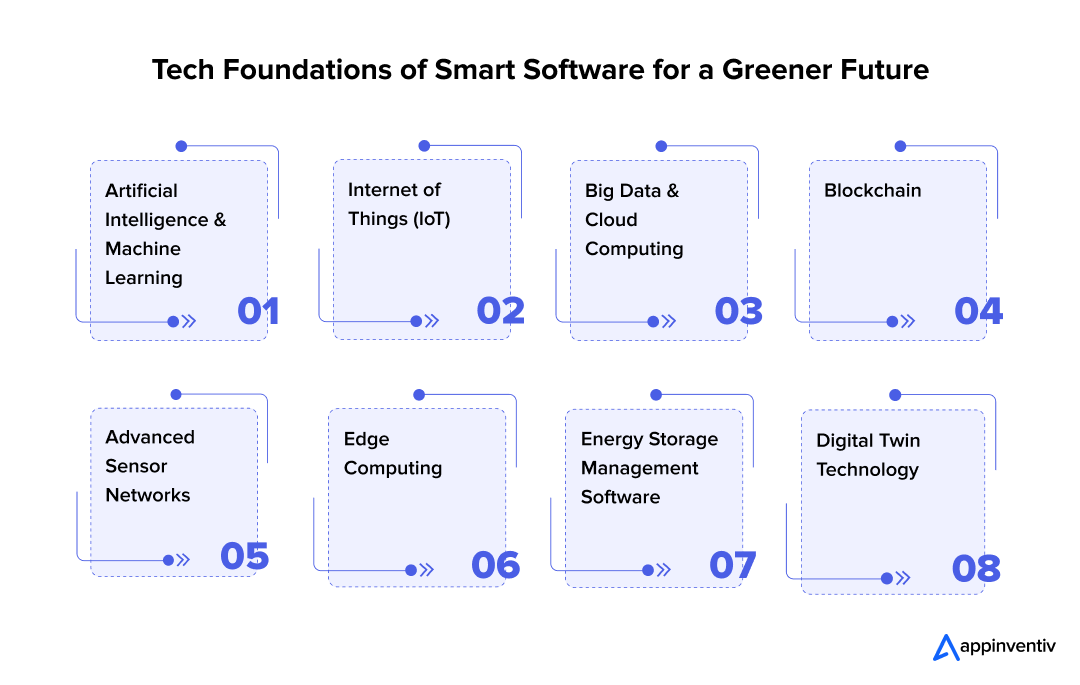
Artificial Intelligence and Machine Learning
Sustainable infrastructure technology like AI and ML is more efficient in energy consumption as it analyzes past and present data to determine the usage patterns that are expected and streamline operations. As per a report by IBM, 9 out of 10 executives believe that AI in renewable energy will play a positive role in helping their organizations meet sustainability goals. Here are other key details which the report furnishes:

Predictive maintenance also decreases equipment downtime, whereas grid balancing with the help of AI will facilitate the successful integration of renewable energy. With smarter infrastructure, organizations can reduce operational costs and promote more sustainable energy practices by leveraging AI in the energy sector.
Internet of Things (IoT)
The IoT devices constitute the nervous system of sustainable infrastructure software, where sensors, meters, and devices provide continuous data. The use of IoT in the energy sector provides the opportunity to monitor energy consumption in real-time, make automated corrections in the system, and perform predictive maintenance. Smart grid systems, factories, and buildings use IoT to minimize waste, enhance productivity, and promote greener operations.
Big Data and Cloud Computing
Cloud-based digital solutions for energy transition enable mass data storage, processing, and analysis. The operators will be in a position to monitor various facilities remotely, identify any gaps in efficiency, and adopt predictive strategies. The use of big data analytics in the energy sector can provide actionable insights into energy consumption trends, helping organizations optimize their resources and plan future infrastructure development.
Blockchain
Blockchain improves the transparency, security, and accountability of the energy transaction, and thus, it is necessary in the smart grid infrastructure. All of the peer-to-peer energy trading, renewable energy certification, and automated billing can be executed on decentralized, trustless systems. Blockchain technology in energy guarantees secure, unaltered information in energy systems, which instills trust and effectiveness.
Advanced Sensor Networks
Precise sensors incorporated into the infrastructure enable the digitalization of energy systems to provide real-time information about temperature, load, and environmental conditions. These sensors enable real-time controls and predictive analytics that enable operators to minimize waste and ensure consistent and efficient systems within buildings, factories, and grids.
Edge Computing
Energy transition software solutions are based on edge computing to make use of local processing of data where it is generated or used. This minimizes the latency, facilitates real-time decision making, and facilitates autonomous system corrections. Cloud analytics are complemented by edge devices that make sure that the responses to the distributed energy system are faster and smarter.
Energy Storage Management Software
The smart software is used to optimize the utilization of batteries and other storage devices along with energy storage systems. Sustainable infrastructure software will be used to control charge-discharge cycles, combine renewable sources, and provide energy when the demand is at its peak. This kind of technology is necessary in achieving a balance between intermittent renewable production and the performance of the grid.
Digital Twin Technology
Digital twins in energy are used to build a virtual copy of physical infrastructure to model, monitor, and improve performance. Sustainable infrastructure technology enables operators to simulate scenarios, anticipate potential breakdowns, and refine maintenance planning without impacting real systems. Smart buildings, grids, and industrial facilities are becoming more equipped with digital twins with the aim of increasing efficiency and decreasing emissions.
Real-World Applications of Smart Software Solutions With Examples
Smart software solutions are changing how we produce, deliver, and consume energy. These technologies use data insights, predictive tools, and automation to support the global push for sustainable infrastructure and better energy efficiency.
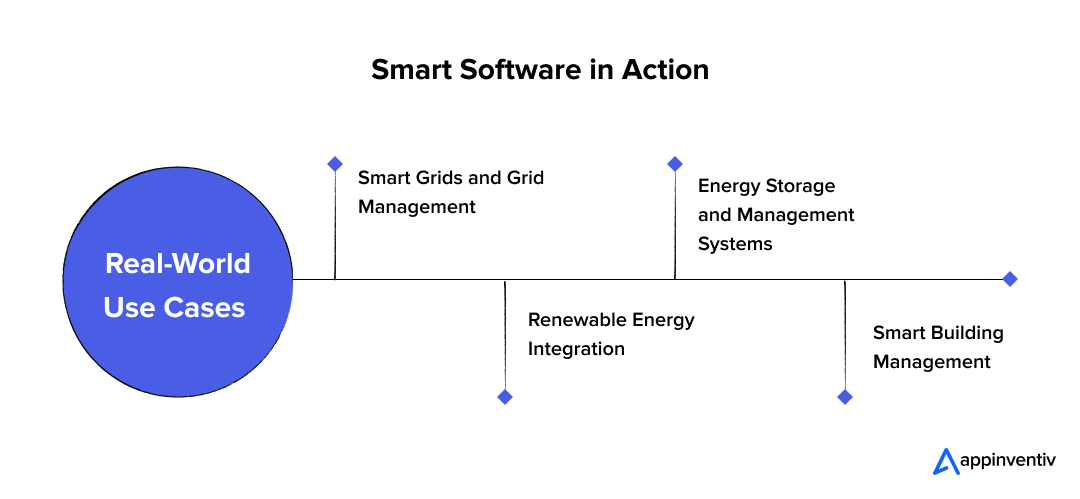
Smart Grids and Grid Management
Moving from old-style power grids to smart grids powered by software solutions has reshaped energy distribution entirely. Traditional grids work with fixed supply approaches, but smart grids adjust energy flow as conditions change, responding to actual demand and network performance. Smart grid digital platforms enable operators to quickly identify issues and integrate renewable sources into the system without complications.
General Electric (GE) built GridOS, a platform that handles grid operations automatically, making systems more reliable and efficient. This technology demonstrates how the digitalization of energy systems can enhance grid management while supporting cleaner energy goals.
Renewable Energy Integration
Getting renewable energy connected to the power grid needs good forecasting and constant fine-tuning. AI in renewable energy enables utilities to accurately predict the amount of electricity solar and wind will produce, thereby maintaining stability when output fluctuates.
NextEra Energy uses AI platforms to run its solar and wind projects. The software determines how weather conditions will impact power output, ensuring a smooth grid connection while maximizing the utilization of renewable sources. This proves how well energy efficiency software handles big utility projects.
Energy Storage and Management Systems
Good energy storage matters a lot for matching unpredictable renewable power with what people actually need. Energy transition software solutions manage battery charging and discharging, predict when demand will peak, and monitor battery health to extend their lifespan.
AES Corporation operates the Alamitos Energy Storage site in California. Software control enables batteries to pump out power during periods of high demand and absorb excess energy otherwise, illustrating the role of energy grid management software in maintaining a steady and functioning grid.
Smart Building Management
Smart building programs regulate the HVAC, light, and other systems according to how many people are in the room and the conditions of the environment. Sustainable infrastructure software monitors energy consumption, automates operations, and makes predictive changes towards consuming less.
Johnson Controls installs Building Energy Management Systems (BEMS) in office buildings. Their AI systems anticipate heating and cooling demand, reduce waste, and increase levels of comfort, demonstrating the potential of energy management systems (EMS) to make operations sustainable.
Challenges and Considerations in Implementing Smart Software Solutions
There is a clear benefit of major gains from implementing smart software solutions in the energy sector; yet, there are significant hurdles to making them widespread. From securing enormous volumes of data to creating a workforce with the appropriate talents, all the challenges require a mindful approach to overcome them.
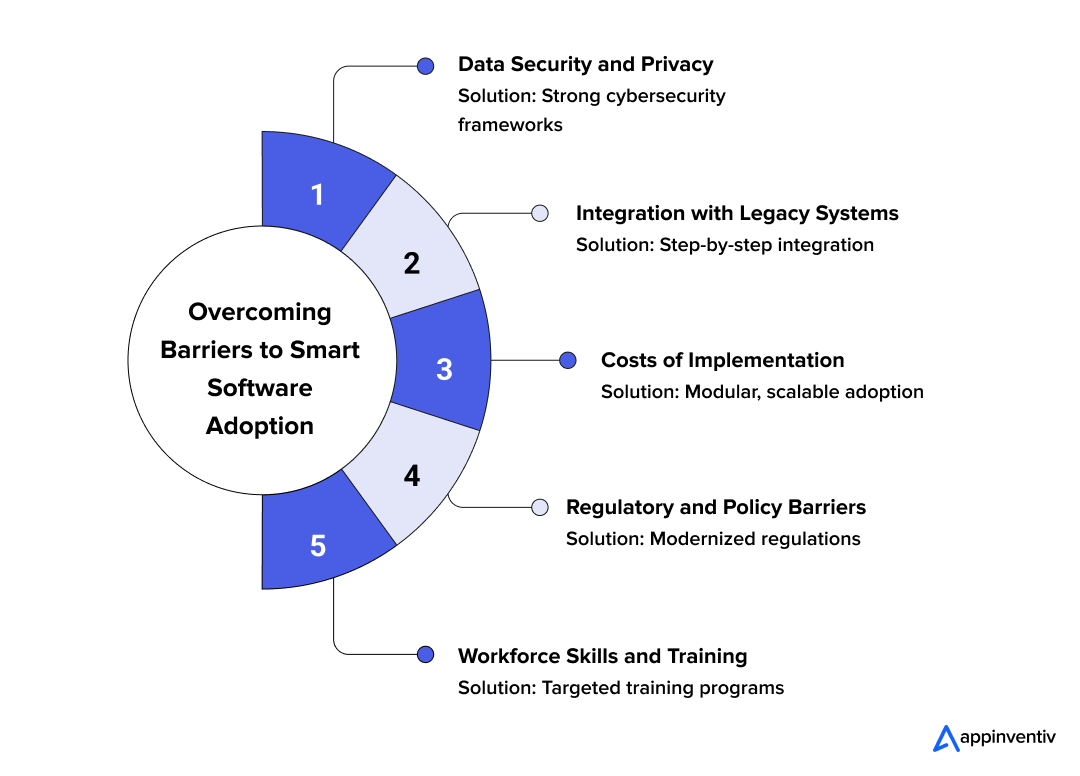
Data Security and Privacy
Smart energy systems create endless streams of sensitive information such as grid performance metrics, consumption patterns, and predictive models. All this data creates bigger targets for cyberattacks, hacking, or accidental breaches. One security mishap could result in blackouts, significant financial losses, or customers losing faith in the system.
Solution: Utilities need to build strong cybersecurity frameworks right into their platforms to protect operations. This involves utilizing multiple layers of encryption, implementing intrusion detection systems, and adhering to international standards. Regular security audits and clear privacy policies help keep regulators and consumers confident. When this groundwork is solid, energy transition software solutions can run safely while supporting reliable, data-based decisions.
Integration with Legacy Systems
Utilities worldwide still run on infrastructure built decades ago. These older systems don’t play well with new digital platforms, making integration both complicated and costly. Trying to slap modern software directly onto outdated equipment often creates inefficiencies, system problems, or downtime that messes with the energy supply.
Solution: Companies should adopt a step-by-step legacy integration approach. Middleware platforms function as bridges between old and new systems, reducing compatibility issues. Open protocols and working closely with vendors also help make sure everything works together. Taking this slower route allows organizations to roll out sustainable infrastructure software without major disruptions to their core operations.
Costs of Implementation
Maintaining the software will require huge investments in software upgrades, licensing, and training. These costs can generally be managed by large utilities, but these smaller operators or developing countries face great financial difficulty.
Solution: The best approach is to go modularly. Scaleable platforms also allow organizations to begin small and grow their implementations as resources become available. Governments and other international entities can contribute towards funding facilities and low-cost financing. In the long run, the investment in smart software to facilitate energy transition can be easily compensated.
Regulatory and Policy Barriers
One of the most controlled industries in the area is energy, and the rules that are in place were not designed considering digital technologies. The lengthy approval procedures, multiple data ownership regulations, and different policies in different regions usually discourage innovative projects by utilities.
Solution: Policy makers need to ensure that their policies keep pace with the changing technology. This involves writing clear cybersecurity policies, simplifying the approval procedure, and establishing incentives for the integration of renewable energy. Regulatory sandbox pilot projects are beneficial. Such flexible structures allow the energy efficiency software to expand without compromising the safety, security, and sustainability criteria.
Employee Skills and Training
Even the optimal platforms are as good as those who operate them. Several utilities are not able to locate a sufficient number of qualified specialists in data analytics and AI, as well as in cybersecurity. Lack of proper training means that the new platforms will be used improperly or not at all, an obstacle in the process of moving to smarter infrastructure.
Solution: The utilities can collaborate with the software firms and colleges or universities to establish special training programs. The promotion of training of existing employees and recruitment of new technical workers will make sure that the organizations are capable of managing advanced platforms. In so doing, companies fully benefit from energy grid management software as well as develop a stronger future operation.
Partner with experts who know how to turn those challenges into lasting results
The Future of Energy Transition Software Solutions
The global push toward renewables is happening fast, and software has become absolutely critical for planning, running, and maximizing clean energy setups. Power and renewable energy software solutions have come a long way from basic monitoring – now they’re full-blown platforms that predict generation, handle storage, and analyze data in real time, giving companies what they need to make better energy decisions.
Here’s where these solutions will really change the game:
Predictive analytics and AI integration: New platforms are using smart software solutions to get ahead of energy demand, squeeze more value from distributed assets, and make operations run smoothly. Companies can now address supply and demand changes before they occur, rather than scrambling to catch up, and they’re reducing their carbon footprint while doing so.
Grid modernization and future planning: Next-gen software will tackle the energy needs of the future by getting microgrids, storage systems, and old-school power networks to work together properly. With everything controlled from one place and full visibility into what’s happening, organizations can bring in more renewable sources without sacrificing reliability or risking outages.
Accelerating the transition: Software isn’t just about managing what you already have – it’s becoming crucial for finding ways to accelerate the renewable energy transition. That means pushing electrification forward, extracting more energy from onsite generation, handling renewable certificates and power purchase agreements, and providing companies with real insights they can act on to meet their sustainability targets across various industries.
Partner with Appinventiv to Build Smart Software for a Sustainable Energy Future
The shift to renewable energy is no longer just a future plan; it has become an operational necessity for organizations seeking sustainability, efficiency, and resilience. Getting through this transition successfully means smart planning, keeping tabs on things in real-time, and bringing everything together across operations. Energy transition software solutions have become must-have tools for this journey, providing predictive analytics, grid management features, and ways to optimize energy generation and storage.
When companies use smart software solutions, they can predict demand, get the most out of renewable assets, and keep energy supply reliable while cutting carbon emissions. Platforms that bring together power and renewable energy software solutions and handle energy needs of the future let organizations make decisions based on actual data, find ways to accelerate renewable energy transition, and discover operational efficiencies they didn’t know existed.
As a trusted energy software development company, we at Appinventiv focus on building innovative, smart, and sustainable software solutions that not only optimize performance but also align with global green initiatives. Our approach emphasizes energy-efficient coding practices, cloud optimization, and the integration of renewable-ready technologies that reduce digital carbon footprints.
We worked with Moo, an innovative electric mobility platform that focuses on sustainable, convenient, and city-friendly eScooter solutions, to build a smart eScooter application that creates smooth user experiences and scalable operations. The outcome was impressive: the app secured Series A funding, demonstrating strong investor confidence, and was launched immediately across three major UK cities, quickly gaining market adoption.
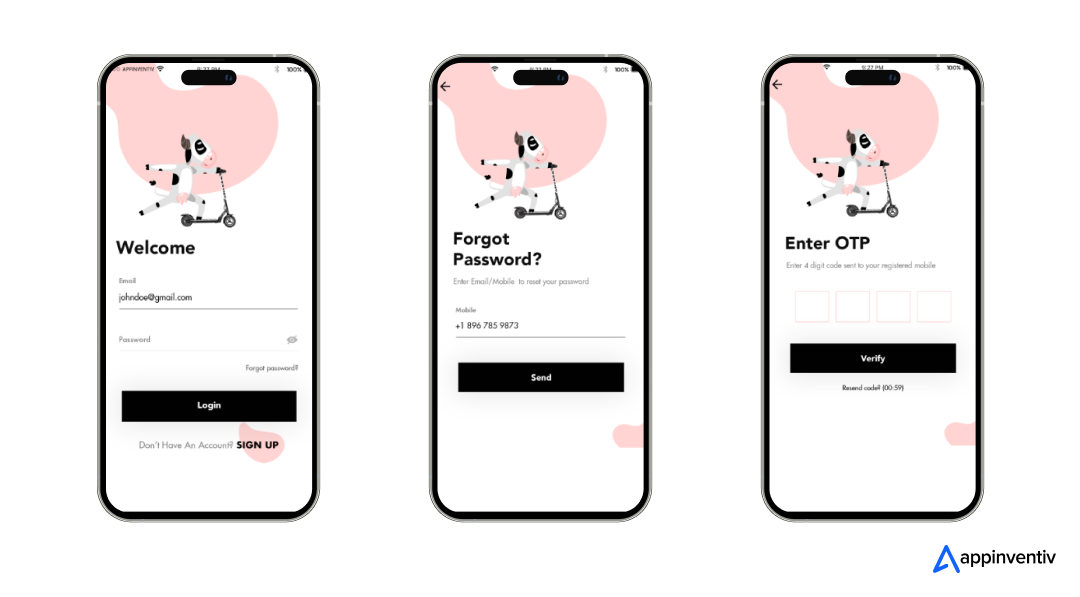
By combining our technology expertise with strategic software development, Appinventiv helped Moo accelerate urban electrification while demonstrating the potential of integrated digital solutions in the clean mobility space.
At Appinventiv, we focus on building intelligent, scalable, and future-ready software solutions that help organizations hit their energy transition targets efficiently. Our client testimonials justify this fact that our tech-led initiatives led to the success of our client’s digital transformation goals. Whether it’s creating advanced platforms, bringing in AI-driven analytics, or optimizing renewable energy assets, our team builds solutions that create real impact.
Connect with us to see how we can work with your organization to speed up your renewable energy journey and turn sustainability goals into actual results.
FAQs
Q. Why is smart software important for renewable energy?
A. Smart software lets operators keep tabs on renewable systems, predict what’s coming, and control everything with accuracy you just can’t get manually. Energy efficiency software helps them identify problems before they become expensive, optimize power usage, and maintain reliable energy flow without exceeding the budget.
Q. How can digital tools reduce carbon emissions?
A. These tools handle the boring stuff automatically, show you exactly where energy goes, and point out obvious ways to cut waste. Energy grid management software enables companies to match their production with their actual needs, resulting in reduced reliance on backup fossil fuel power and lower emissions.
Q. What are the top technologies driving sustainable infrastructure in 2025?
A. Here are some of the top technologies that drive sustainable infrastructure in 2025:
- AI in renewable energy for smarter predictions and better performance
- Advanced energy storage systems
- Smart grids and grid modernization
- Electrification solutions, including EV fleets and industrial systems
- Integrated renewable energy software solutions
- Advanced sensors and IoT devices for monitoring and control
Q. How can software accelerate the clean energy transition?
A. Software platforms make it much easier to plan, manage, and scale up renewable energy projects. Energy transition software solutions enable organizations to see exactly where they stand, optimize their power generation, and make informed decisions based on actual data, all of which accelerates the transition away from carbon.


- In just 2 mins you will get a response
- Your idea is 100% protected by our Non Disclosure Agreement.
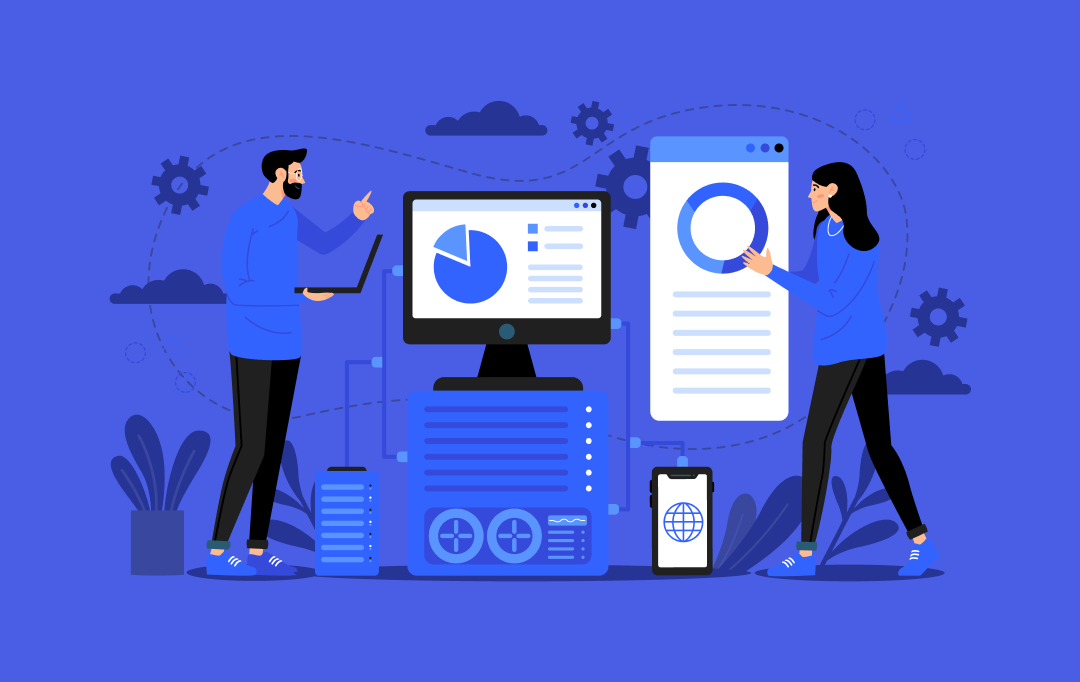
How Much Does It Cost to Build a White-Label Enterprise Procurement Software?
Key takeaways: The development of white-label enterprise procurement software typically costs between $50,000 and $500,000, depending on complexity and features. Key features include vendor management, budget tracking, purchase approvals, and invoice automation. Flexible monetization models - from modular licensing to integration fees- can future-proof revenue streams. Building a custom white-label solution gives you long-term control…
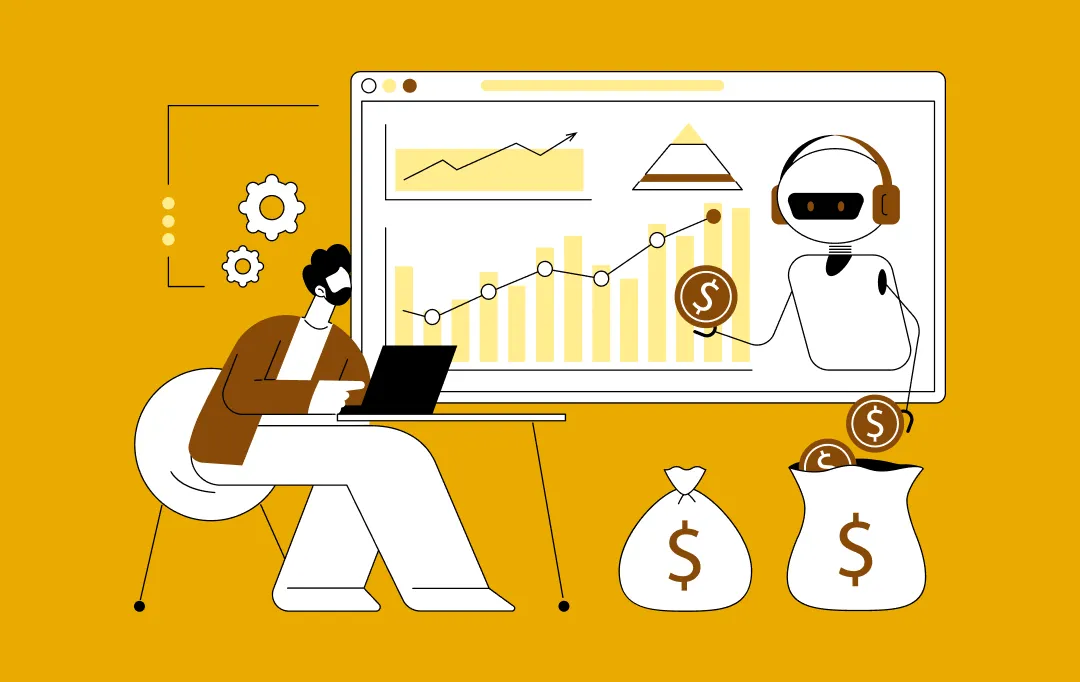
A Clear Breakdown of Custom Software Development Costs for Businesses in Canada
Key takeaways: Custom software in Canada typically ranges from CAD 55,00 to 550,000 ($40,000 to $400,000), depending on scope, integrations, and compliance. Costs rise in regulated sectors due to PHIPA, PCI DSS, AML rules, and strict Canadian data residency requirements. Planning, modular architecture, and cloud native services help control the software development cost in Canada…
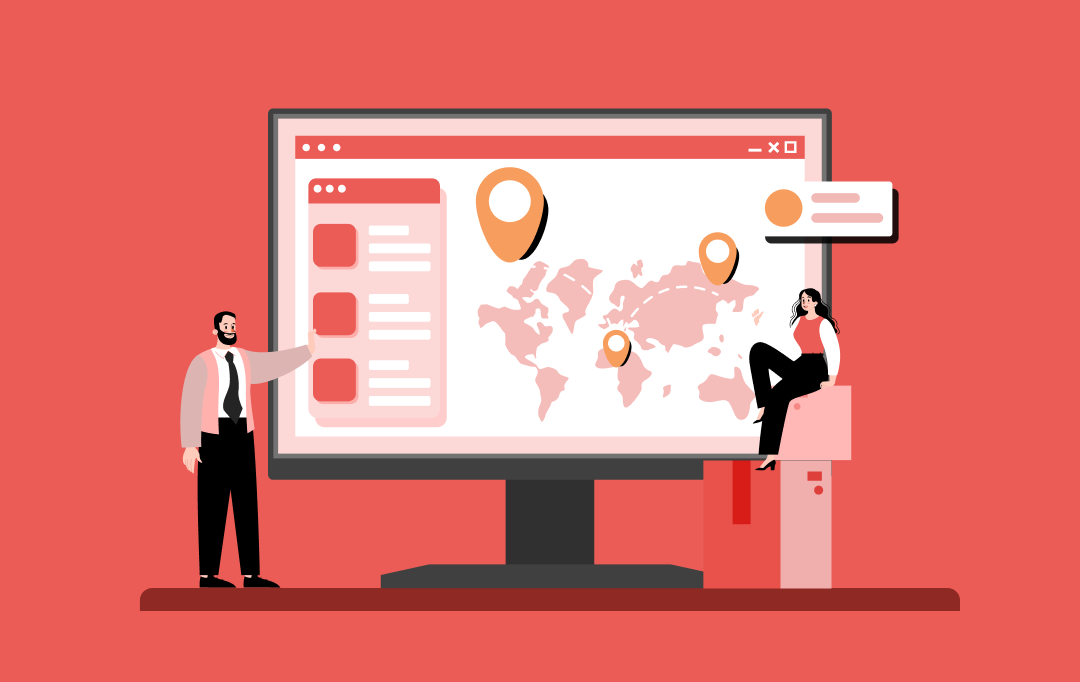
The Real Cost of Building Professional Delivery Management Software
Key takeaways: Custom delivery management software has complete flexibility, scale, and integration, which conforms to the distinctive requirements of business. Fluid connection to ERP, CRM, and payment systems also introduces a large amount of complexity and additional cost, but is the key to efficiency. It is important to design scalable systems to grow in the…











